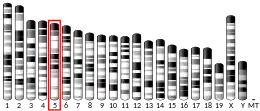Glypican 2 (GPC2), also known cerebroglycan, is a protein which in humans is encoded by the GPC2 gene.[5][6] The GPC2 gene is at locus 7q22.1 and encodes for a 579 amino acid protein.[7] The C-terminus of GPC2 has the GPI attachment site, at G554, and the N-terminus encodes a signal peptide, from M1 to S24. Multiple GPC2 mRNA transcripts have been identified.[8] GPC2-201 is the isoform overexpressed in pediatric cancers. Tumor-associated exon 3 of GPC2 shows the lowest expression in normal tissues compared with other exons.[8]
Function
Cerebroglycan is a glycophosphatidylinositol-linked integral membrane heparan sulfate proteoglycan found in the developing nervous system. Cerebroglycan participates in cell adhesion and is thought to regulate the growth and guidance of axons.[9] Cerebroglycan has especially high affinity for laminin-1.[10]
Implications in cancer
GPC2 has been identified as a therapeutic target in neuroblastoma in two independent studies published by Dr. Mitchell Ho's lab at the NCI and Dr. John Maris's lab at the University of Pennsylvania in 2017.[11][12] GPC2 is highly expressed in about half of neuroblastoma cases and that high GPC2 expression correlates with poor overall survival.[11][13] GPC2 silencing inactivates Wnt/β-catenin signaling and reduces the expression of N-Myc, an oncogenic driver of neuroblastoma tumorigenesis.[11] Chimeric antigen receptor (CAR) T cells and Immunotoxins (antibody-cytotoxin fusion proteins) targeting GPC2 inhibit neuroblastoma growth in mouse models.[11] The Ho lab at the National Cancer Institute generated a mouse monoclonal antibody called CT3 targeting human GPC2.[8] The CT3 antibody has been shown to recognize a tumor-associated isoform (isoform 201) of GPC2 with high affinity.[8] Immunohistochemistry using CT3 shows that the antibody has high binding signals on neuroblastoma, medulloblastoma, and retinoblastoma.[8] CT3 does not bind human normal tissues except the testis.[8] CT3-derived CAR T cells regress neuroblastoma in mice.[8][14] The CT3 mAb is commercially available for Western blot, flow cytometry, immunohistochemistry, and immunofluorescence. A GPC2 specific antibody-drug conjugate (ADC) can inhibit neuroblastoma and small-cell lung cancer cell proliferation and tumor growth in mice.[12][15]
See also
References
- 1 2 3 GRCh38: Ensembl release 89: ENSG00000213420 - Ensembl, May 2017
- 1 2 3 GRCm38: Ensembl release 89: ENSMUSG00000029510 - Ensembl, May 2017
- ↑ "Human PubMed Reference:". National Center for Biotechnology Information, U.S. National Library of Medicine.
- ↑ "Mouse PubMed Reference:". National Center for Biotechnology Information, U.S. National Library of Medicine.
- ↑ Stipp CS, Litwack ED, Lander AD (January 1994). "Cerebroglycan: an integral membrane heparan sulfate proteoglycan that is unique to the developing nervous system and expressed specifically during neuronal differentiation". The Journal of Cell Biology. 124 (1–2): 149–160. doi:10.1083/jcb.124.1.149. PMC 2119891. PMID 8294498.
- ↑ "Entrez Gene: GPC2 glypican 2".
- ↑ Li N, Spetz MR, Li D, Ho M (July 2021). "Advances in immunotherapeutic targets for childhood cancers: A focus on glypican-2 and B7-H3". Pharmacology & Therapeutics. 223: 107892. doi:10.1016/j.pharmthera.2021.107892. PMC 8202769. PMID 33992682.
- 1 2 3 4 5 6 7 Li N, Torres MB, Spetz MR, Wang R, Peng L, Tian M, et al. (June 2021). "CAR T cells targeting tumor-associated exons of glypican 2 regress neuroblastoma in mice". Cell Reports. Medicine. 2 (6): 100297. doi:10.1016/j.xcrm.2021.100297. PMC 8233664. PMID 34195677.
- ↑ Ivins JK, Litwack ED, Kumbasar A, Stipp CS, Lander AD (April 1997). "Cerebroglycan, a developmentally regulated cell-surface heparan sulfate proteoglycan, is expressed on developing axons and growth cones". Developmental Biology. 184 (2): 320–332. doi:10.1006/dbio.1997.8532. PMID 9133438. S2CID 23283933.
- ↑ Herndon ME, Stipp CS, Lander AD (February 1999). "Interactions of neural glycosaminoglycans and proteoglycans with protein ligands: assessment of selectivity, heterogeneity and the participation of core proteins in binding". Glycobiology. 9 (2): 143–155. doi:10.1093/glycob/9.2.143. PMID 9949192.
- 1 2 3 4 Li N, Fu H, Hewitt SM, Dimitrov DS, Ho M (August 2017). "Therapeutically targeting glypican-2 via single-domain antibody-based chimeric antigen receptors and immunotoxins in neuroblastoma". Proceedings of the National Academy of Sciences of the United States of America. 114 (32): E6623–E6631. Bibcode:2017PNAS..114E6623L. doi:10.1073/pnas.1706055114. PMC 5559039. PMID 28739923.
- 1 2 Bosse KR, Raman P, Zhu Z, Lane M, Martinez D, Heitzeneder S, et al. (September 2017). "Identification of GPC2 as an Oncoprotein and Candidate Immunotherapeutic Target in High-Risk Neuroblastoma". Cancer Cell. 32 (3): 295–309.e12. doi:10.1016/j.ccell.2017.08.003. PMC 5600520. PMID 28898695.
- ↑ Li N, Spetz MR, Ho M (December 2020). "The Role of Glypicans in Cancer Progression and Therapy". The Journal of Histochemistry and Cytochemistry. 68 (12): 841–862. doi:10.1369/0022155420933709. PMC 7711243. PMID 32623934.
- ↑ Sun M, Cao Y, Okada R, Reyes-González JM, Stack HG, Qin H, et al. (January 2023). "Preclinical optimization of a GPC2-targeting CAR T-cell therapy for neuroblastoma". Journal for Immunotherapy of Cancer. 11 (1): e005881. doi:10.1136/jitc-2022-005881. PMC 9835961. PMID 36631162.
- ↑ Raman S, Buongervino SN, Lane MV, Zhelev DV, Zhu Z, Cui H, et al. (July 2021). "A GPC2 antibody-drug conjugate is efficacious against neuroblastoma and small-cell lung cancer via binding a conformational epitope". Cell Reports. Medicine. 2 (7): 100344. doi:10.1016/j.xcrm.2021.100344. PMC 8324494. PMID 34337560.
External links
- GPC2+protein,+human at the U.S. National Library of Medicine Medical Subject Headings (MeSH)



